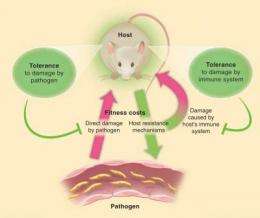New strategies for treatment of infectious diseases

The immune system protects from infections by detecting and eliminating invading pathogens. These two strategies form the basis of conventional clinical approaches in the fight against infectious diseases. In the latest issue of the journal Science, Miguel Soares from the Instituto Gulbenkian de Ciência (Portugal) together with Ruslan Medzhitov from Yale University School of Medicine and David Schneider from Stanford University propose that a third strategy needs to be considered: tolerance to infection, whereby the infected host protects itself from infection by reducing tissue damage and other negative effects caused by the pathogen or the immune response against the invader. The authors argue that identifying the mechanisms underlying this largely overlooked phenomenon may pave the way to new strategies to treat many human infectious diseases.
Upon invasion by pathogens (bacteria, viruses or parasites), the immune system kicks into action, by detecting, destroying and ultimately eliminating the pathogen. This so-called "resistance to infection" is crucial in protecting the host from infection, but is often accompanied by collateral damage to some of the host's vital tissues (liver, kidney, heart, brain). If uncontrolled tissue damage may have lethal consequences, as often happens, for example, in severe malaria, severe sepsis and possibly other infectious diseases. Tolerance reduces the harmful impact of infection and of the ensuing immune response on the host.
Although a well-studied phenomenon in plant immunity, tolerance to infection has been largely overlooked in mammals, including humans. While there is still much to be learnt about how and under which circumstances tolerance to infection is employed by the host, most of what is currently known about the molecular mechanisms underlying this host defense strategy comes from work carried out at the Instituto Gulbenkian de Ciência by the group led by Miguel Soares. The team is particularly interested in identifying disease-specific tolerance mechanisms, on the one hand, and also general strategies of tolerance, that may, possibly, be employed protectively, to precondition the host to future infections.
Because resistance is, generally, the only mechanism considered in animal and human studies, when the host capitulates to infection it is often attributed to failure of the immune system. The authors argue that this is not always the case, and underscore the importance of distinguishing between failed resistance and failed tolerance as the cause for morbidity and mortality by infectious diseases. This distinction will dictate the choice of therapeutic approaches. When the primary problem is failed tolerance, then boosting the immune system, or administering antibiotics, may be ineffective. In this case, enhancing tolerance would possibly be much more effective in fighting infectious, inflammatory and auto-immune diseases.















